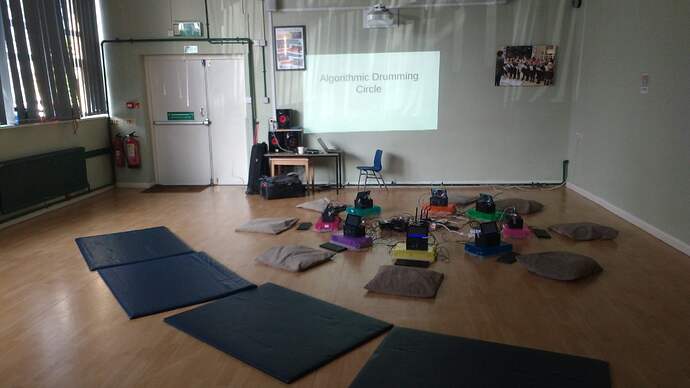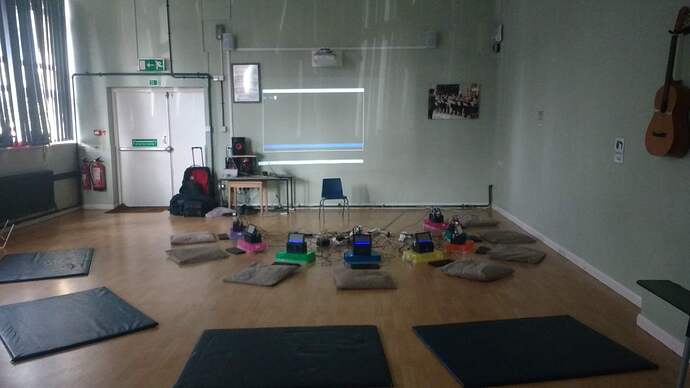Hi all,
I renamed this thread to ‘workshop reports and resources’, make sense?
I ran six school workshops with year 3s (mostly 7 year olds) this week, here’s a quick report. Questions/thoughts welcome!
I did them as participatory ‘algorithmic drumming circles’, I wrote about an earlier iteration for ICLC 2019, you can read the paper here:
iclc.livecodenetwork.org/2019/papers/paper76.pdf
I worked with Y4s (mostly 8 year olds) before, but these Y3s were more able to get into it, they had better grasp of the keyboard, I think because the school had managed to give them a chromebook each. I’ve realised it’s really important to work with a whole year group. Picking out a small group of children, or a single class, is not good for the harmony of the school!
Still, the biggest challenge was getting them used to the editor, a lot of them expected the backspace key to delete the character under the cursor, rather than the one to the left. They all got it after a bit of prompting, though.
So I could cover the whole year over two days, I ran six sessions, each with a group of eight, for an hour. I had TidalCycles running on raspberry pi’s, set up on the floor, each with a speaker (a passable powered studio monitor).
For the first day, I ran it like this, with the children in a circle:
The second day, I changed a few things including making more of a horseshoe:
This worked better, I was included in the circle, and the children could better see the screen. I also changed some other things the second day after reflecting on the first day, the structure I ended up with
- Getting them to sit on mats for a few minutes,
- introducing myself as an artist who likes to code (I was there as part of a project is about getting ‘real’ artists into schools)
- Getting them to guess what we were going to do (getting them to identify the computer and speaker)
- Motivating and explaining things by showing them a couple of short video clips - one of me playing as part of CCAI at BlueDot festival, so they can see the code as part of a performance, and the start of the guardian video, the first minute or two being a really nice intro showing diverse voices explaining how expressive and easy it is to get into live coding
- Showing a picture of a ‘real’ drumming circle, explaining that it’s about listening to each other and playing together, saying we’ll do something similar but with computers
- Showing the editor, showing them how the editor works and demonstrating how to make either a high and low sounds
Then we went straight into making some sounds, I got half the group typing in "hi" and half typing in "lo", and pressing alt-enter to run it. (I found at this point having all the speakers at low volume was key, it was actually easier to pick out the sounds from the closest speaker then.) They all picked up holding down the keyboard modifiers (shift or alt) pretty quickly. With the network sync, they were already playing together, hitting a drum in unison.
I then got them to all do alt-h to stop the sound, and talk them through repeating the sound by adding *2 or *3 to make e.g. "hi*3". This took getting them to use cursor keys and correcting mistakes with backspace… Actually a challenge as it’s not clear that you place your cursor to the right of the character you want to delete or insert. The later sessions I made this clearer in my demos which helped.
The overall music at this point was already really great, with polymetrical effects. With one group I got them to stand up and walk around the circle listening to the rhythms at this point.
Some kids were already jumping ahead at this point, by realising you could run multiple patterns on separate lines, or put in extra words inside the speech marks. Either way I stopped them a couple more times and introduced more ‘tricks’ and ‘secrets’ to make ‘stranger patterns’.
- making a sound
- repeating sounds
- making sequences of repeating sounds
- transforming those with ‘functions’ -
scratch (which granulates and reverses the sounds and sequence), faster which speeds up playback of sequence and audio rate (using hurry), slower which does the opposite, crunch which does bitcrushing
- applying those functions conditionally with
every and sometimes
That was about the right amount to get through inside an hour, leaving plenty of time for experimentation and play, allowing them to explore polyrhythm and other interference patterns while allowing them to take advantage of higher-order functions.
There were certain tendencies I became aware of
- focussing on sound rather than pattern. I learned to constrain them to just two sounds - high and low (although they each had their own high and low drum samples)… Otherwise they’d just spend the whole hour triggering different sounds instead of focusing on the patterns, transformations of them, and listening to each other. If they asked for more sounds I’d let them play with some in the last five minutes though.
- not wanting to delete their code. I decided not to challenge this one at all, and instead show them how to have multiple patterns going at once, and how to switch them on and off (with alt and a number shown next to each pattern). I found some of them really wanted to share the patterns they made at the end, so we went round playing each one. Although they all seemed very happy to play in the drumming circle, some didn’t want to play their pattern alone, I put no pressure on them.
- pushing things to extremes, doing
faster $ faster $ faster "hi*10000000000000" etc. I’d normally encourage this kind of thing, but this time their teacher would ask them to try doing a less intense one for a while. On reflection this was probably for the best.
- trying to typing in a particular rhythm they have in mind, rather than exploring creatively. Just a bit of encouragement to just try things out was enough to keep them asking ‘what if I do this?’ rather than ‘how do I do this?’
Overall feedback from them was really good. Some said they wanted to do melodies, or beatbox sounds etc. Maybe I could mix in some pentatonic basslines or something, but at least for an hour workshop, really constraining the sounds basically to a kind of bongo each does seem for the best. When they did ask for more sounds during the workshop, giving them some sound effects to explore seemed to satisfy them anyway… and made it about exploring movement rather than just surfing through sample libraries.
A lot asked if they could run it at home / get it on steam etc - “how do we get onto this website?”. My biggest regret is Tidal’s rather difficult install process, the next step is solving that! Plus maybe having funding to give them a tidal pi zero each… For now I’ll get some information to them with links to a range of live coding environments so they can continue their exploration.
For this project I also need to make an extra activity for the teacher to run - I’ll do this around hydra, which they should be able to get running on their chromebooks straight away, and get similar instant results in the visual domain.
Anyway, masses of fun! All 48 children were really engaged and into it, and I learned a lot and improved the sessions as I went. There was a full-on flossing session at the end of the last one.

